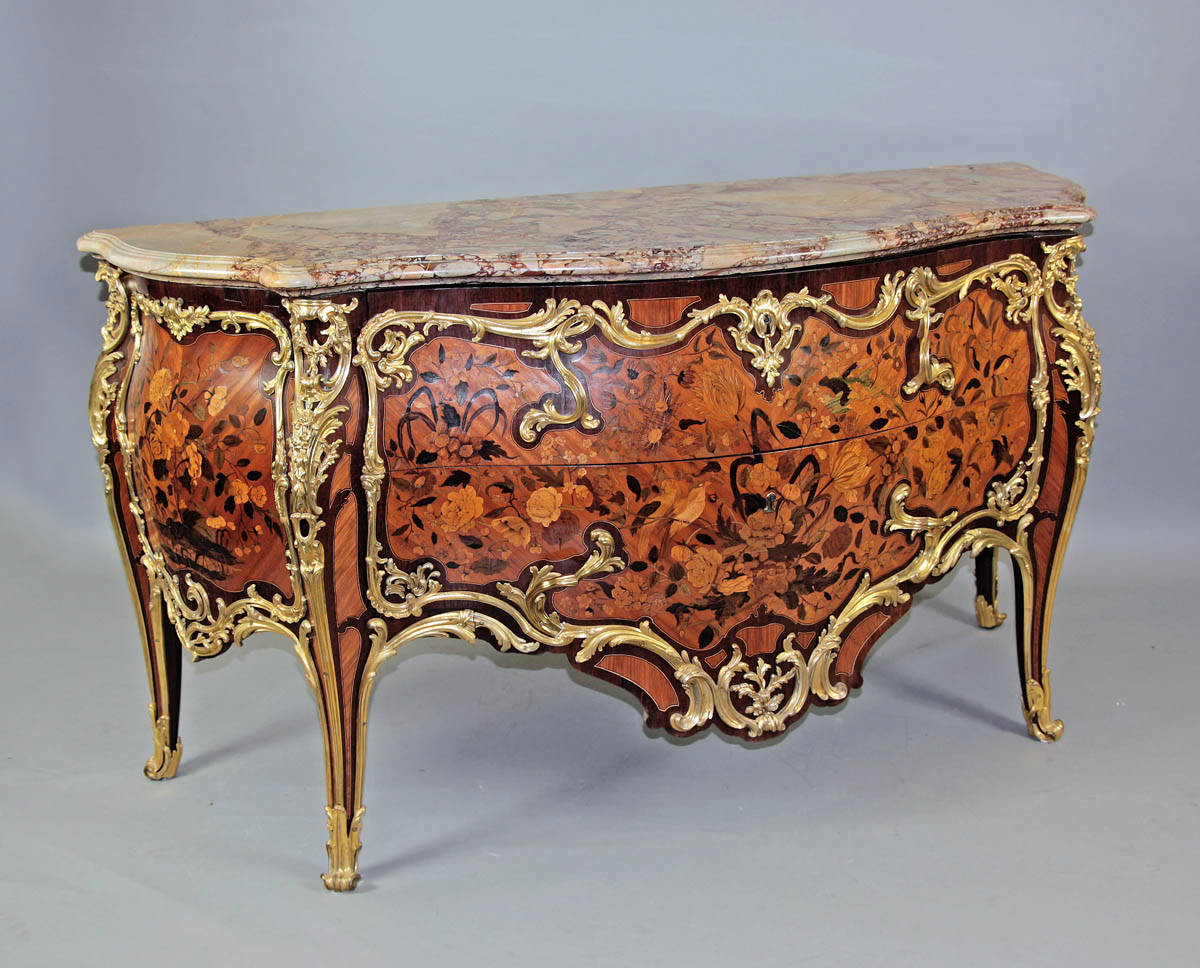Anet-commode
This is the so-called ‘Anet’-commode. Although the front is beautifully decorated, the stamps and marks on the back are an important part of the story of its provenance research.
The brand stamp on the back of the commode refers to one of its original owners, the Duke of Penthièvre who resided at the Castle Anet near Paris in the 18th century. The stamp most likely refers to his official title as Admiral of France, and the first and last letters of his castle’s name.
The commode’s contemporary paper trail starts in 1941, when it was purchased by the Deutsche Reichsbank from B. Fabre & Fils, a Parisian art dealer. The number “Rb 634” on the back presumably refers to its new home in Nazi Germany: the Reichsbank in Berlin. During the war, the commode was kept in its basement. In 1952, it was transferred by the Ministry of Finance of the German Democratic Republic to the Märkisches Museum, today's Stadtmuseum Berlin.

The commode was rediscovered in the depot of the Stadtmuseum in 2015. In 2019, research into the commode was authorised, as it was suspected to be looted art. Today, the outcome of this research shows that there is no evidence yet to classify it as such. However, it is still unknown where the commode was at the beginning of World War II, so the provenance research continues. Check the QR code for potential updates.
In the animated documentary provenance researcher Regina Stein talks about her work on the history of the commode.
Marks
This commode is part of an ongoing provenance study of 47 pieces of antique furniture in possession of the Berlin Stadtmuseum. Experts suspect that they were bought in Paris during the city’s German occupation (1940-1944). The furniture in this bundle that were intended for the German Reichsbank, bear a so-called Rb number. All the furniture has been thoroughly examined for marks to identify makers, sellers, previous owners or exhibitions. For the Anet commode, these appear to be scarce:
No maker’s mark
Because the maker did not mark the commode, it is attributed to Jean-François Oeben based on its stylistic features and dated around 1750.
No. I
In symmetrical 18th-century interiors, many pieces of furniture had a duplicate. ‘No. I’ suggests the possible existence of an identical copy of the commode, but this has not yet been located.
Rb 634
The highest Rb number found so far is 1272. This could mean that the Reichsbank acquired more than a thousand objects during the war. The Stadtmuseum is still actively searching for objects with Rb numbers in other museums.
AT
The letters A and T are the first and last letters of the word Anet, the residence and castle of the commode’s owner in the 18th century, the Duke of Penthièvre. The anchor refers to his title as “Amiral de France”.
More research
The commode was included in a list of missing works of art compiled by the French after the war. But not all missing objects were robbed. While we know that the Reichsbank bought the commode in 1941 from the Parisian antique dealer B. Fabre et Fils, its prior ownership history is still unclear. Although B. Fabre et Fils is no longer in business, the family still holds the entire shops’ archives. A first look at the sales books in this extensive archive didn’t turn up any findings, so we do not yet know from whom the commode was acquired. So far, there is no concrete evidence of illegal expropriation, but more research is being done to rule this out for the period from 1933 to 1941.
Turning point
The 1998 Washington Conference brought renewed attention to the material damage suffered by Jewish victims of the Second World War. Fourty-three countries signed the resulting Washington Principles, a non-binding commitment to a fair resolution of issues related to Nazi-confiscated art. In Germany, this led to the creation of the Arbeitskreis Provenienzforschung, a leading network of provenance researchers. International cooperation and data sharing are crucial to resolving the remaining cases, many of which are highly complex.
The Netherlands
In the Netherlands, too, there have been initiatives to return stolen cultural objects to their rightful owners following the Washington Conference, and Dutch museums are conducting research on objects in their collections. Initially, provenance investigations were limited to the Dutch war period (1940-1945), but this was later expanded to include the years following 1933, when the Nazis came to power in Germany and began confiscating art.
The situation in the Netherlands during the war is further explained next to Rembrandt’s self-portrait in this room. More information about the Netherlands’ efforts with regard to provenance research and restitution is available on our website.
